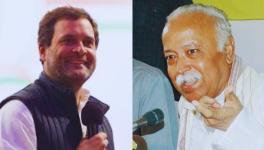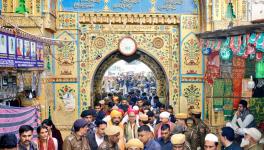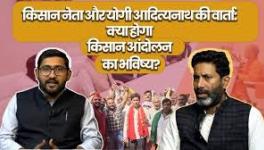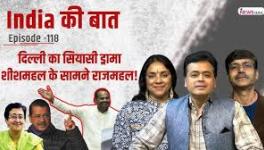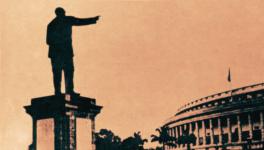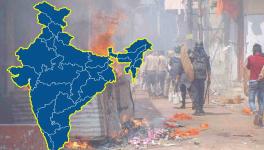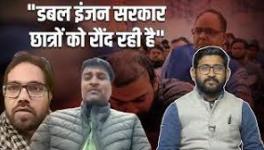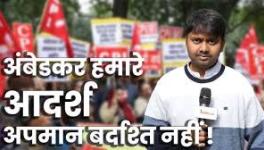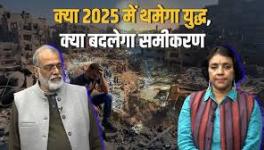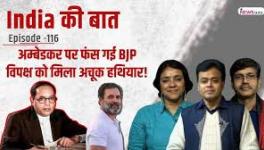BJP Widens Religious Fault Lines Before 2024 Election

Four seemingly unconnected recent developments are part of the Sangh Parivar playbook, now opened as an emergency measure to further prise fault lines in society on lines of religious identity because the BJP is in more than a spot of electoral bother.
The first of this quartet of occurrences is the assertion of Uttar Pradesh chief minister (CM) Yogi Adityanath that referring to the Gyanvapi complex in Varanasi as a mosque will create a dispute and that now is the time for the Muslim community to come together and acknowledge that historical mistakes have been made, and make amends.
Adityanath’s statement ignites a political controversy in an effort that has so far been restricted to weaving a legal jumble in multiple courts involving numerous cases many overlapping over one another to get the mosque declared as having been built over a temple, thereby forcing the way to its demolition.
The statement of the one-time Hindu monk with strong-arm tactics as a panacea will doubtlessly trigger reactions from adversaries. But this will only enable consolidation of the BJP’s pro-Hindutva supporters.
The statement was made at a critical time as the Allahabad High Court (HC) and the Supreme Court (SC) are due to pronounce their verdicts on separate matters related to the dispute over the Gyanvapi Mosque.
For a person on a constitutional post, this statement, on the eve of the verdicts, smacks of interference in the process of adjudication and is an undisguised endorsement of the legal plea of the Hindu litigants in the case.
While the SC will give its verdict on August 3 on the issue of the District Court’s directive to the Archaeological Survey of India to conduct a detailed survey, including excavations—if necessary—of the contentious site, the HC will rule on the main civil suit for ownership of the disputed property, ongoing through a complicated process since 1991.
The dispute over this shrine in Varanasi, importantly Prime Minister Narendra Modi’s Lok Sabha constituency, was reopened by the combination of the Union and state governments in collaboration with the BJP and various affiliates of the Sangh Parivar in the past three years.
While the affiliates engaged themselves in complicating the legal muddle, various departments of the two governments aimed at furthering the belief that the mosque merely exists on borrowed time. This was done by widespread demolitions around the Kashi Vishwanath temple and the construction of the Ganga River corridor.
However, all this was executed against the spirit of the apex court’s Ayodhya judgement of November 2019. Importantly, it put a lid over all disputes pertaining to mosques claimed by Hindutva groups as being built on Hindu temples and so needed to be ‘restored’ to the majority community.
Adityanath’s assertion is self-contradictory. On every matter regarding minority rights and safeguards, the troika of Centre-BJP-RSS disallows individuals or organisations to speak on behalf of the community.
Paradoxically now, the CM is asking “Muslim society” to make the declaration that Aurangzeb committed a historical mistake and this should be undone by razing the mosque and building a new temple over the same site.
Adityanath’s call replicates demands made by various elements with Hindu sectarian forces three decades ago before the Babri Masjid’s demolition.
It is an incontrovertible fact that since there is no competent body representing all Indian Muslims with the right to cease ownership over the Gyanvapi Mosque and site, Adityanath’s call is little but an instance of dog whistle politics.
It has been sounded with elections in mind, similar to Modi inaugurating the Kashi Vishwanath Temple Corridor project in December 2021 when Assembly elections, swept by the BJP in March 2022, were imminent.
The second of these episodes was enacted over four days by Sanjeev Balyan, Union Minister of State for Fisheries, Animal Husbandry and Dairying, when he walked for more than 80 km on the highway from Haridwar to his constituency, Muzaffarnagar, in the second week of July.
The ostensible purpose was pilgrimage, it being the Hindu month of Sawan, when devotees in thousands carry water on foot from the Ganga River to the Shiv temple nearest to their colony or village home.
Despite this being the stated purpose, it was a mere ruse to preach to living in villages, towns and cities on the way besides the muscle brigade of the Hindu fold as kanwarias (people undertaking the Kanwar Yatras) can be aptly called.
The subject of Balyan’s sermons, which he delivered every 10 or 20 km, was that the Uniform Civil Code (UCC) is essential for the country and must be supported despite opposition (mainly from Muslims and some opposition parties, a section of civil society and political activists) to it.
Balyan is no ordinary BJP leader and Muzaffarnagar is not a nondescript parliamentary constituency. The district was the site of major communal riots in 2013 and the communal polarisation stemming from these incidents laid the basis for the BJP’s sweep of UP. Balyan was a key accused and alleged one of the main pivots of communal violence against Muslims in western UP districts.
The trend held true for the 2017 Assembly election. A few months prior to the polls, in a conversation with this writer, Balyan reminded that “Rajnitik hawa paschim se chalti hai (Political winds begin from the west)”.
During the election, Modi whipped up majoritarian sentiments with his infamous speech criticising the then-Samajwadi Party government: “Gaon me kabristan banta hai to shamshaan bhi banna chahiye; Ramzan me bijli ati hai, to Diwali me bhi aani chahiye. (If a village gets a graveyard, it should get a cremation ground too. If there is electricity during Ramzan, there should be electricity during Diwali too)”.
A decade later, Balyan knows that to ensure the BJP’s victory, the safest way would be to blur the lines between religion, religious identity and politics again.
The minister tried to enlist bellicose Hindu youth who throng Kanwar Yatras annually to support the UCC. Their backing was sought by conveying to them that this was a necessary response of the Hindus in the face of Muslim opposition to the proposal.
This campaign is an unmitigated instance of blurring the lines between religion and politics. The basic issues in this, ensuring gender justice while upholding India’s pluralism, are completely obfuscated.
The third development in this quarter is Modi’s Mann Ki Baat, broadcast on Sunday, July 30. In his radio interaction, Modi used culture and religion as synonyms. This has been a running theme of the century-long effort to popularise Hindutva among people. This is also often articulated as this nation’s cultural nationalism and posed as a counter to the territorial notion of nationalism.
The prime minister too dwelt on this theme in his programme when he reminded listeners that the episode was being broadcast during the month of Sawan when Kanwar Yatras are taken out.
From this part, he seamlessly transited from talking about a large number of Yatris to stating that listeners:
“...would also be happy to know that the number of people reaching Banaras is also breaking records. Now, more than 10 crore tourists are reaching Kashi every year. The number of devotees visiting pilgrimages like Ayodhya, Mathura and Ujjain is also increasing rapidly. Due to this, lakhs of poor are getting employment; their livelihood is being taken care of. All this is the result of our collective cultural awakening. (sic)”
The entire credo of Hindutva is based on the claim that being Hindu is not a religious identity but a cultural affiliation. This is the basis for the Sangh Parivar’s claim that everyone living in this country is a Hindu regardless of their faith—be it even Islam or Christianity.
The hordes that turn up in Haridwar to begin Kanwar Yatras—the number has been progressively increasing with the passage of years and as advocacy of Hindutva grew by leaps and bound in the 21st century—do so because of enhanced religious fervour.
Modi and other Hindutva votaries, however, present this as “the result of our collective cultural awakening.” In the election year, this deliberate erasure of lines is not without intent for it ends up creating a pan-Indian Hindu identity but camouflaging it as a cultural label.
It is important to understand the correlation between Modi’s assertion and Adityanath’s demand from Muslims. The record number of visitors to Varanasi is due to the “collective cultural awakening”, says Modi. This sentiment would only get enhanced with Adityanath’s call as it also acts as a call to Hindus to gather in the Kashi Vishwanath complex to add to the public pressure against the Gyanvapi Mosque.
The last episode is, of course, the deliberately triggered communal violence in parts of Haryana on the fringes of the southwestern part of the National Capital Region. There were reports of a Gurugram mosque being attacked leading to a mob-led murder of its 19-year-old Naib Imam.
Even meat shops were targeted in Gurugram, indicating that this had become a full-fledged communal riot and was no longer restricted to a result of a belligerent state-backed show of strength by the Vishwa Hindu Parishad (VHP) units in the district of Nuh.
Violence may be checked in the coming days, mainly because riots in close proximity to Delhi as the much-trumpeted G-20 Summit nears, would be publicity in the global media that Modi can do without.
But the assertions of BJP leaders like Haryana CM Manohar Lal Khattar that the violence was sparked only after the VHP procession was attacked when passing through Muslim colonies would only deepen the communal divide in a region that has been beset with frequent clashes between Hindu cow vigilante groups and Muslim meat traders.
The administration giving clearance for such provocative processions indicates that the State wishes to trigger violence with the aim of harnessing its electoral gains via the Hindu consolidation route.
The endgame is the same for all the aforesaid events. While the episodes involving Modi and Yogi would add to the creation of a media-led discourse, the action of Balyan and possibly many BJP leaders like him throughout the country would strengthen the motivation of the belligerent Hindu youth.
Situations like the communal conflagrations at Nuh and now Gurugram is the ultimate objective of the Sangh Parivar. The BJP has become synonymous with a party in power in states that witness communal violence—Uttarakhand, Uttar Pradesh and now Haryana.
The Opposition will have to find ways to minimise such occurrences although, at this stage, it is tough to fathom how this can be done in today’s India.
The writer is an NCR-based author and journalist. His latest book is ‘The Demolition and the Verdict: Ayodhya’ and the ‘Project to Reconfigure India’. His other books include ‘The RSS: Icons of the Indian Right’ and ‘Narendra Modi: The Man, The Times’. He tweets at @NilanjanUdwin.
Get the latest reports & analysis with people's perspective on Protests, movements & deep analytical videos, discussions of the current affairs in your Telegram app. Subscribe to NewsClick's Telegram channel & get Real-Time updates on stories, as they get published on our website.









